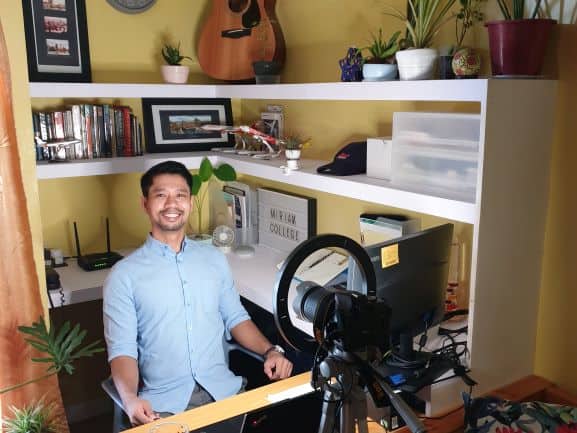Resty C Collado is a physics teacher at Miriam College High School in Quezon City, Philippines
This post is part of a series on how the COVID-19 pandemic is affecting the personal and professional lives of physicists around the world. If you’d like to share your own perspective, please contact us at pwld@ioppublishing.org.

As a physics teacher, I am used to standing in front of students in a classroom, teaching and engaging them face-to-face. Now that the pandemic has forced schools and universities to reconsider face-to-face classes, two 21st-century concepts have become buzzwords: work from home (WFH) and online distance learning (ODL).
As the popularity of WFH and ODL increased, the popularity of Zoom, the virtual meeting app, increased as well. Suddenly, teachers all over the world found themselves presenting lessons in front of a camera hooked to a computer, “facing” students sitting behind screens many kilometres away.
This method of communication projects the complex physical self into a composed, quiet, virtual identity. For a full week in April, I attended daily four-hour Zoom meetings. During this time, my default device setting was a muted microphone. I turned off my camera for two reasons: to trade upload speed for download speed, and to save every precious bit of my tight data allowance. I was there to listen, so I spoke only when acknowledged, my physical self muted and turned into a meticulously handpicked profile picture. From a fun-loving jokester, I was turning into a faceless, lifeless and soulless being. In short, I was becoming a Zoombie.
Birth of the Zoombies
It is a cliché to say that technology gifts us connectivity, especially at a time when physical connections are impossible. But the trade-off is a lack of physical interaction, and even a reduction in the feeling of being alive. All I saw on my screen or heard from my speakers was a stream of ones and zeroes; all sights and sounds were converted to electrical currents. I sat in front of the laptop with my ears, eyes and brain glued to the device – not with eager focus, but with the sort of lazy attention manifested by hunched shoulders, drooped eyes, and uninspired fingers.
At first, I thought I might be the only one who felt this way. But as my Zoom meetings increased in number and frequency, I noticed that most participants were doing the same thing. Microphones muted, cameras off, sporadic chat messages: lifeless personae drudging in and out of meetings. Soon, I realized that students may be having the same experience with ODL delivered in synchronous sessions. Muted, unresponsive, answering only when asked, detached and bereft of life, the numbers of Zoombies were increasing at a rate that would put 10 seasons of The Walking Dead to shame. And I would not have any of it.
The fight to stay alive
As a classroom teacher I took it upon myself to keep my classes alive even if lessons had to be conducted via Zoom. By harnessing my more-than-a-decade experience as an educator, I knew I could find ways to bring my virtual classroom to life.
The first conclusion I drew is that synchronous class meetings must be as succinct and targeted as possible to shorten the highly regulated environment of a Zoom meeting. This mode should be reserved for important and urgent matters, such as setting learning targets and deliverables for the week, explaining the most challenging concepts, deciding on a particular class issue, and – I believe this is of the highest importance – providing life and socialization to the virtual classroom.
My second conclusion is that there should be a checking-in routine. Letting students interact with each other, even for a brief period, can inspire attention and engagement. Assigning different hosts and “passing” the microphone whenever possible – all while encouraging candidness and candour in front of the camera, just as you would in a classroom – can also improve interaction.
Third, teachers should seek ways to elicit discussion and interaction among students. This can include integrating live polls or quizzes, asking thought-provoking questions, or demonstrating discrepant events (a favourite of science teachers) in front of the camera. In short, we must inject life into our virtual classrooms. The more the students feel alive, the less their chances of turning into Zoombies.
Fourth, as teachers, we should remember that some of our students may have limited connectivity in terms of Internet speeds and data caps. We must wear the hat of a connoisseur (choosing the best learning material), and a museum curator (laying out the virtual class like a museum with themed galleries) when designing our online courses. We should make each minute count and every moment meaningful. This not only enables students to use their time and data allowances efficiently, it also encourages their agency as learners. Let them explore the virtual classroom on their own in an asynchronous mode, moving and learning at their own pace rather than being herded or forced to follow others.
Fifth, and last, it is lovely to bid students goodbye before they exit at the end of a week or a learning stage, through a synchronous interaction. Once again, this is a way to inject life and make them look forward to the next learning session.
World War Z(oom)
As we try to keep our students from becoming Zoombies, we must also consider the pandemic’s side effect: a general feeling of anxiety. Some of our students might be anxious about missing school and friends, studying at home without a conducive environment or schedule, or worried about family members whose jobs or health have been affected. Leaving our students in such a worried state adds momentum to their Zoombie transformation.
The best weapon we can use in this war against Zoombies is to encourage positive student–student and teacher–student relationships in our virtual classes. For example, how can an online course evoke a genuine interest in everyone’s wellbeing and safety during the pandemic? Is it possible to elicit the contexts in which students are learning, and then use those contexts in designing classroom activities?

Physics in the pandemic: ‘There are some great experiments that can be done safely and simply at home’
These actions may require extra effort, but if we wish to design our online classes in a truly human-centred way, such questions must be front and centre in our considerations. Instead of students feeling that they are listening to pre-recorded lectures, reading plain texts, or taking tests that are automatically checked and marked by an algorithm, a virtual classroom with a “beating heart” makes a potent weapon against Zoombification.
Finally, we need to remember that we are not teaching remotely in normal circumstances, but during a health emergency of global scale. When we accept this truth, it becomes easier to keep students feeling alive in our classes. Because if Zoom turns our students into lifeless and unresponsive beings, that would be scarier than all the world’s zombie movies combined.
- A longer version of this article appears as a Letter to the Editor in the journal Physics Education, which – like Physics World – is published by IOP Publishing.



